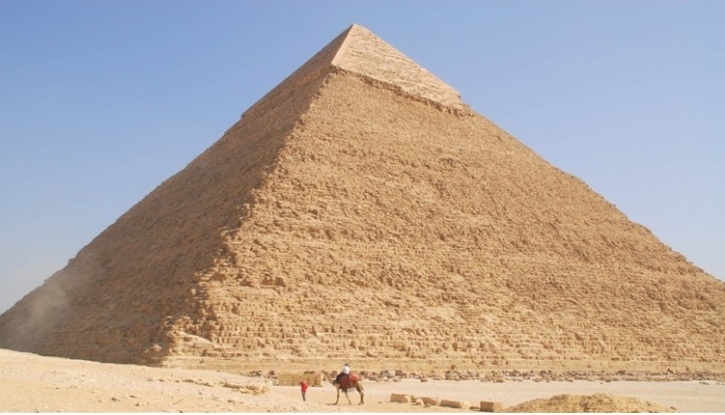Introduction: The Power and Mystery Behind Egypt’s Second Tallest Pyramid
When we think of the Giza Plateau, the spotlight is often on the Great Pyramid of Khufu. But just a few steps away stands a slightly smaller yet equally magnificent structure: the Chephren Pyramid. This timeless wonder, built by Pharaoh Khafre (also known as Chephren), rises majestically from the desert sands and continues to captivate historians, travelers, and explorers alike.
With its limestone casing still visible at the top, the Chephren Pyramid holds an aura of preservation, mystery, and silent strength. This is more than just an ancient tomb—it's a testament to the legacy of a king and the grandeur of the Fourth Dynasty of ancient Egypt.
%2C%20third%20Pharaoh%20of%204th%20Dynasty%20during%20period%20of%20Old%20Kingdom%2C%20around%202540%20BC.%20.jpg)
Who Was Pharaoh Chephren?
Pharaoh Chephren, son of Khufu (builder of the Great Pyramid), ruled during the Fourth Dynasty around 2558–2532 BC. He followed in his father’s architectural footsteps, commissioning not only a pyramid for his own eternal rest but also the iconic Great Sphinx of Giza, believed to bear his likeness.
Unlike some pharaohs whose legacies faded with time, Chephren's presence has endured thanks to the monumental structures he left behind, both imposing in size and rich in symbolism.
Architectural Marvel of the Chephren Pyramid
The Chephren Pyramid, originally 143.5 meters (471 feet) tall, now stands at 136.4 meters (448 feet) due to erosion. Despite being slightly shorter than Khufu’s pyramid, it appears taller due to its elevated foundation and steeper angle of construction.
Key features of this pyramid include:
-
Limestone Casing: The smooth outer casing, now largely gone from most pyramids, still caps Chephren’s pyramid, giving a glimpse into its original glory.
-
Perfect Geometry: Its base spans 215 meters on each side, aligned precisely with cardinal points.
-
Mortuary Temple: Located on the east side, this temple was used for rituals honoring the deceased king.
-
Causeway: A covered passage connecting the mortuary temple to the valley temple, part of an elaborate funerary complex.
What to Expect When Visiting the Chephren Pyramid
Visiting the Chephren Pyramid is a journey into both engineering brilliance and spiritual legacy. Here's what you'll encounter:
-
Striking Exterior: The pyramid retains a unique charm thanks to its limestone crown.
-
Inner Chambers: Unlike Khufu’s pyramid, Chephren’s has fewer internal corridors, but its burial chamber features granite walls and a sarcophagus.
-
The Sphinx Connection: Just steps away is the Great Sphinx, believed to guard Chephren’s complex.
-
Panoramic Views: The pyramid offers fantastic vantage points to view the Giza Plateau and its surroundings.
Tips for Visiting the Chephren Pyramid
-
Best Time to Visit: Early morning or late afternoon to avoid the midday heat.
-
Tickets: Entry is often bundled with general Giza Plateau tickets, but separate access may be required for inner chambers.
-
Stay Hydrated: Bring water, sunglasses, and a hat. The desert sun is intense.
-
Use a Guide: With Flying Carpet Tours, you get insightful stories and historical depth from expert guides.
-
Photography: You can take pictures outside freely, but interior photography may be restricted.
Combine Your Visit with Nearby Attractions
Maximize your day on the Giza Plateau with these nearby must-sees:
-
Great Pyramid of Khufu: The oldest and largest of the three pyramids.
-
Mycerinus Pyramid: The smallest pyramid on the plateau but no less significant.
-
The Great Sphinx: Half-lion, half-man, this colossal statue watches over Chephren’s legacy.
-
Solar Boat Museum: Explore the reconstructed boat buried next to the pyramid to serve the pharaoh in the afterlife.
.jpg)
Suggested Itinerary: A Pyramid Day in Giza
-
Morning: Start with the Chephren Pyramid and explore its mortuary and valley temples.
-
Midday: Visit the Great Pyramid and the Solar Boat Museum.
-
Afternoon: Wrap up at the Sphinx, then enjoy local food in a nearby restaurant with pyramid views.
-
Evening: Consider catching the Sound and Light Show at the pyramids for a magical end to your day.
Why the Chephren Pyramid Stands Out
While Khufu's pyramid often gets the glory, the Chephren Pyramid stands apart in its design, symmetry, and enduring beauty. Its polished limestone capstone and proximity to the Sphinx give it a dramatic silhouette that defines the Egyptian horizon.
It's also a place that invites deeper thought—a monument to a king who wanted his story told in stone, across the ages.
Final Thoughts
If you're planning a visit to Egypt and want to experience the grandeur of ancient royalty without the overwhelming crowds, the Chephren Pyramid is a must. It's a place where ancient engineering meets spiritual symbolism—where the desert whispers the legacy of a forgotten pharaoh.
Unlock the timeless secrets of the Chephren Pyramid with Flying Carpet Tours—and explore where history and mystery meet.

